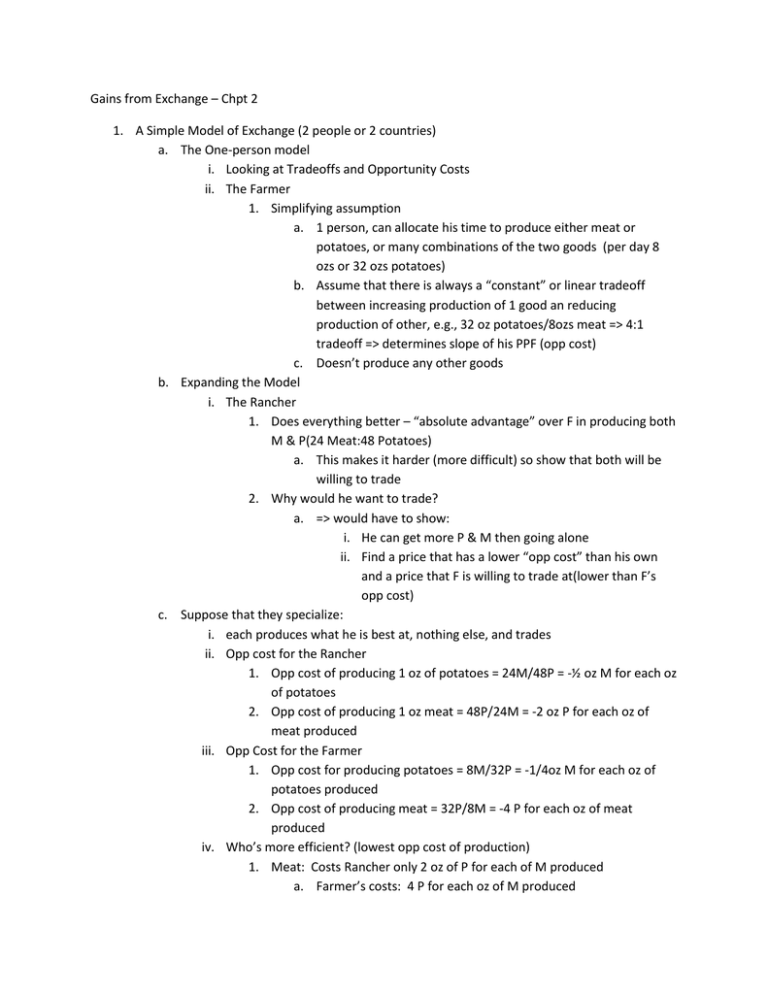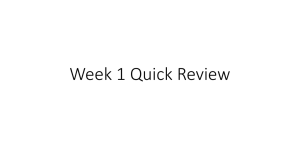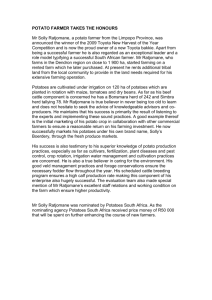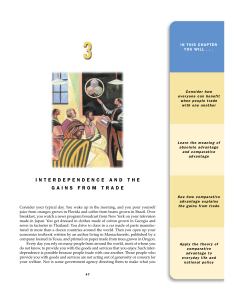Gains from Exchange – Chpt 2 a. The One-person model
advertisement

Gains from Exchange – Chpt 2 1. A Simple Model of Exchange (2 people or 2 countries) a. The One-person model i. Looking at Tradeoffs and Opportunity Costs ii. The Farmer 1. Simplifying assumption a. 1 person, can allocate his time to produce either meat or potatoes, or many combinations of the two goods (per day 8 ozs or 32 ozs potatoes) b. Assume that there is always a “constant” or linear tradeoff between increasing production of 1 good an reducing production of other, e.g., 32 oz potatoes/8ozs meat => 4:1 tradeoff => determines slope of his PPF (opp cost) c. Doesn’t produce any other goods b. Expanding the Model i. The Rancher 1. Does everything better – “absolute advantage” over F in producing both M & P(24 Meat:48 Potatoes) a. This makes it harder (more difficult) so show that both will be willing to trade 2. Why would he want to trade? a. => would have to show: i. He can get more P & M then going alone ii. Find a price that has a lower “opp cost” than his own and a price that F is willing to trade at(lower than F’s opp cost) c. Suppose that they specialize: i. each produces what he is best at, nothing else, and trades ii. Opp cost for the Rancher 1. Opp cost of producing 1 oz of potatoes = 24M/48P = -½ oz M for each oz of potatoes 2. Opp cost of producing 1 oz meat = 48P/24M = -2 oz P for each oz of meat produced iii. Opp Cost for the Farmer 1. Opp cost for producing potatoes = 8M/32P = -1/4oz M for each oz of potatoes produced 2. Opp cost of producing meat = 32P/8M = -4 P for each oz of meat produced iv. Who’s more efficient? (lowest opp cost of production) 1. Meat: Costs Rancher only 2 oz of P for each of M produced a. Farmer’s costs: 4 P for each oz of M produced 2. Potatoes: Cost Farmer only 1/4 oz M for each oz of P a. Rancher’s cost: ½ oz of M 3. Rancher: lowest cost of producing meat; Farmer lowest cost of producing potatoes v. What if we “specialize” and allow them to trade 1. Rancher produces only meat => 24 oz M 2. Farmer produces only potatoes => 32 oz P vi. What would they trade at 1. Rancher’s own cost of producing 1 oz P = ½ oz M (willing to sell if he can get > 2P for 1 M) 2. Farmer’s own cost of producing 1 oz M = 4P (willing to buy if 1 oz M costs him < 4 oz P) 3. How about if the market price is 3P for 1M? (Both could gain) vii. What would happen if they traded at this price? 1. Rancher starts at: (24M, 0P) => (23 M, 3P) (trades 1 oz M for 3P) a. On his own: to get 3 ozs P = 3(-1/2) M => -1.5M => (22.5M, 3P) 2. Farmer starts at: (0M, 32P) => (1M, 29P) after trade a. On his own: cost -4P for +1M => (1M, 28P) viii. Greg’s example 1. Assume each would have originally produced at mid-pt of PPF a. Farmer: (4M, 16P) b. Rancher: (12M, 24P) 2. Rancher a) stars at (18M,12P), b) then sells 5 oz M; gets 15oz of P a. (18M, 12P) => (13M, 27P) b. Outside his own PPF (12M,24P) => better off 3. Farmer specializes in potatoes, i.e., produces only P; then trades 15 oz P for 5 oz M a. (0M, 32P) => (5M,17P) b. Outside his own PPF (4M,16P) => better off 2. Maintained Assumptions: Effect of Changing Them a. Only 2 people (or countries) and 2 goods => can add more of both, but harder to keep track of graphically => have to go to equations i. But conclusion about benefits of gains from trade remains ii. Opportunity costs are constant iii. Implies a linear trade-off => slope of graph (opp costs) is constant iv. Real world: opportunity costs increase as more of the good is produced 1. “specialization of labor” => hire most productive (output per person) first, less productive labor 2. PPF is non-linear b. Measure slope of PPF (and hence opportunity costs) by a) constructing a tangent line to the curve (line that touches PPF at only 1 point) and b) measuring the slope of that line



